So...2021, as far as reenacting is concerned, was better than the previous year, though covid and the fears that go with it has still reared its ugly head.
Much of the following text, of which was modified with my own interjections, came from a book I own called "
A Time-Traveler's Guide To Medieval England" by Ian Mortimer. The words expressed fit my thoughts nearly to a " T " ~ ~ ~ ~
 |
| Another year in the past... |
So----when does living history cease to be pretending...?
Well, as soon as you start to think of the past as happening (as opposed to it having happened), a new way of conceiving history becomes possible. Reenacting and, to an even greater extent, living history, allows us to to see the inhabitants of the past in a more sympathetic way: not as a series of graphs and charts showing data of age, race, sex, or occupations, but, rather, as investigations into the sensations of being alive in a different time. You can start to gain an inkling as to why people did this or that, and even why they believed things which we may find simply incredible. You can gain this insight because you know that these people are human, like you, and that some of the reactions are simply natural. In being able to do this sort of time-travel or, what I also call mind-travel, allows one to understand these people not only in terms of evidence through research, but also in terms of their humanity, their hopes and fears, the drama of their lives.
It is in this way we can be reminded that history is much more than a strictly educational process. Truly understanding the past is a matter of experience as well as knowledge; it is a striving to make a spiritual, emotional, poetic, dramatic, and inspirational connection with our forebears. It is about our personal reactions to the challenges of living in previous centuries and earlier cultures, and our understanding of what makes one century different from another. We know what love, fear, pain, anger, grief, sadness, and anxiety is like today. Those in the past knew as well. This is the human relation we have with our forebears.
To accomplish this sort of living history/reenacting is to use, utilize, and include many different source materials, especially primary sources (no, a Hollywood movie is, by far, the least "source" you would ever want to use). It is also necessary, in my opinion, to research everyday life of the period in a thorough manner and, where no primary sources are available, one can use this external knowledge gained of the time as well as using reason to help to bring certain aspects of the past to life. By reason I mean to get your head, as best as you can, out of today - out of modern thought - and into the realm of your knowledge of the past (hence, the importance of actual research by way of journals, letters, diaries, and broadsides - many of which are available in book form---click
HERE for one example).
And then there is the clothing and striving to improve on what you wear---again, through research.
Whenever dressed period, I believe reenactors/living historians should work to not allow today's thoughts, biases, and other modernisms to invade the past, for that can, simply put, greatly ruin the impression you have spent so much time and money to perfect...not just for you but for everyone, and though impossible to extract all modern thinking, we should at the very least do our best to keep as much of this at bay as possible (aside from then to now comparisons).
Unfortunately, the modern world doesn't always cooperate. Airplanes may fly overhead. Smoke alarms can be seen inside historic buildings. Fire extinguishers, cell phones, sometimes electric lights, cars, cameras...and even supposed living historians themselves who can't seem to keep from speaking of modernisms (or wearing wristwatches), all may intrude on your experience and become a reminder that you are not representing the past, much in the same way the 1979 penny did for Richard in the movie "Somewhere In Time."
The intrusions are infinite, but I do my best to try not to be a part of or notice them.
And that makes my job much harder.
But maybe if I can break on through to that other side, you can, too.
So here, then, is my year in the past. A snippet - a glance -of every time I put on my period clothing:
January began slow. Due to covid hanging around and the media continuing their scare tactics, we had no colonial Christmas party and no Civil War Christmas party...sort of. I did have a small - very small - gathering of friends from our Civil War group over just because I had to - - and I really wanted to.
 |
| A small 1860s gathering of friends for Christmas. |
Then, toward the
end of January, a few of us spent a winter's day in and around a frontier cabin, making the grand attempt to recreate a day from the early 1770s:
 |
| The Sound of Winter Memory, or a Day Given to Provision |
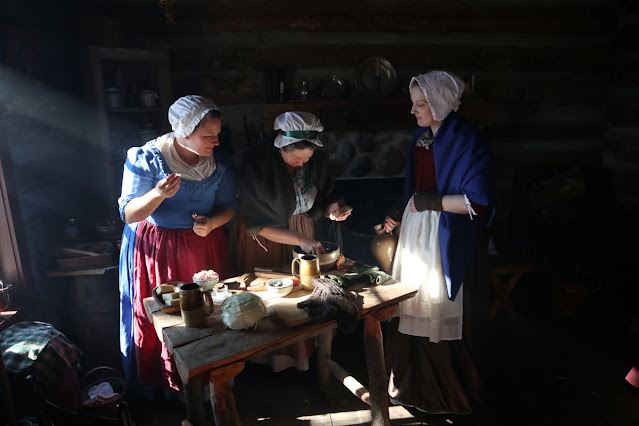 |
| The ladies prepared our afternoon meal... |
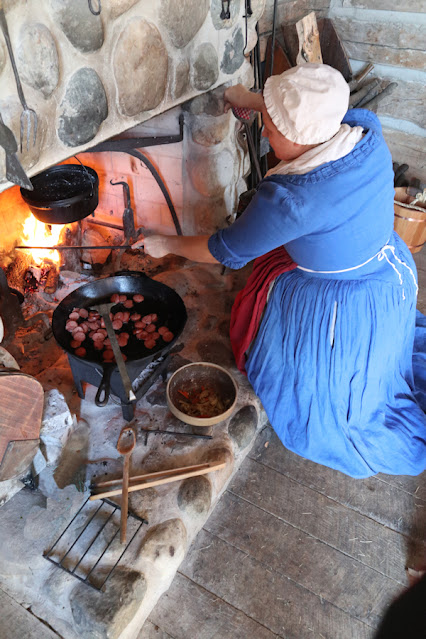 |
...then cooked it on the hearth.
The peas porridge hot was so good on a winter's day. |
 |
It was a good day to process the flax for spinning.
I am using my flax break here. |
I also used the scutching board and hackle in the flax processing so it could be spun into linen thread.
 |
| And that is what Rebecca is doing here - spinning the processed flax into linen thread. |
 |
| It was cold on this late January day, and just as was done in the old days, we wore our outdoor garments while indoors to keep warm. |
 |
| We spoke of how folks who actually lived in the 18th century slept in such frigid weather, for the fireplace does not necessarily throw out the heat as one would think. |
Unfortunately, we had nothing going in the living history department of life during the gray bland and boring month of February.
However, in March, we were almost back to normal, for we had a couple of historic activities:
 |
| One was the period dress meeting of the members of Citizens of the American Colonies. |
 |
The other March event was for Larissa & I when we presented to a group of
elementary school kids.
We both very much enjoy doing presentations for schools as well as historical societies, reenactments, libraries, fairs, and most anywhere else we're asked. Our two themes are historic farming, as seen here, and The Patriots where we portray Sybil Ludington, Paul Revere, and Bob Stark joins us as Ben Franklin. |
April was a pretty fun month for being in period attire. I always make sure I commemorate Patriot's Day - April 19th - in some form or another.
No...Patriot's Day is
not on September 11th - it is, as I mentioned, on April 19th - the 1st battle of the American Revolution---Lexington & Concord (Paul Revere made his famous "midnight ride" the night before). So I ventured to historic Greenfield Village while dressed in my colonial clothing and spent time around houses that were standing during the American Revolution.
 |
The brother of one of the riders who rode with Paul Revere on that fateful night of
April 18, 1775 - Abel Prescott (brother of Samuel) - pounded upon this door,
awakening the sleeping Thomas Plympton and had him alarm the town of Sudbury
that the Regulars were on the march to Concord. |
And there I was...at the very same...
Perhaps the biggest surprise for me was when my wife came out of our "bed chamber" dressed in her colonial clothing! "Wait---what? You're going with me...and taking part??"
Yes!!
 |
| Here we have my wife and I, both dressed appropriately for a farm couple. |
 |
| In our real life, my wife is heavily into gardening and has grown our own kitchen garden at home, often planting heirloom plants. Much of what she learned about the ancient plants came directly from Daggett presenters over the many years we have visited. |
You may or may not know that I have turned a small portion of our home into a sort of replication of a colonial home, so upon returning on the Patriot's Day, we snuck in a quick picture.
 |
Patty is spinning on her wheel and I am writing in my ledger.
My idea and ability to create a colonial scenario in my "modern" 1944 home is explained in this post: Daggett-izing My House. |
To a small extent, we are living out our dreams we used to speak about during our dating period back in the 1980s. Yes, this is exactly what we spoke of: heirloom gardens, spinning, and doing other activities of the past.
So now
May has come and our core of merry living history time-travelers have found ourselves back at the frontier log cabin once again. You see, we don't just sit back and speak about life in the past while here----we actively take part in the activities of time gone by. There is no "pretending" going on, as you will see in the following photos:
 |
| The band of merry time-travelers are ready for another day spent in the early 1770s! |
 |
The cabin was a mite dusty, with a few cobwebs to boot,
so Charlotte dusted and cleaned the windows. |
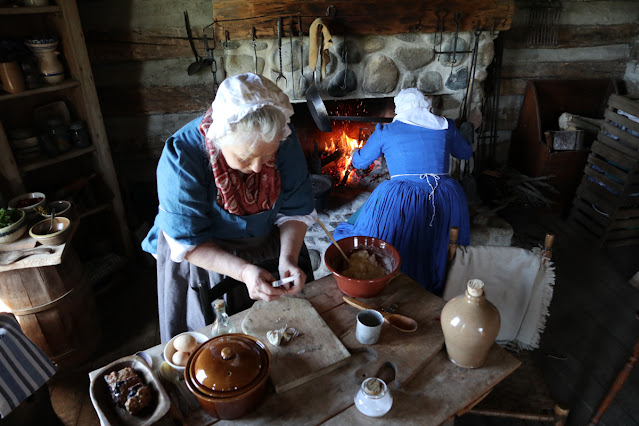 |
| Jackie and Larissa prepared and cooked our meal over the hearth. |
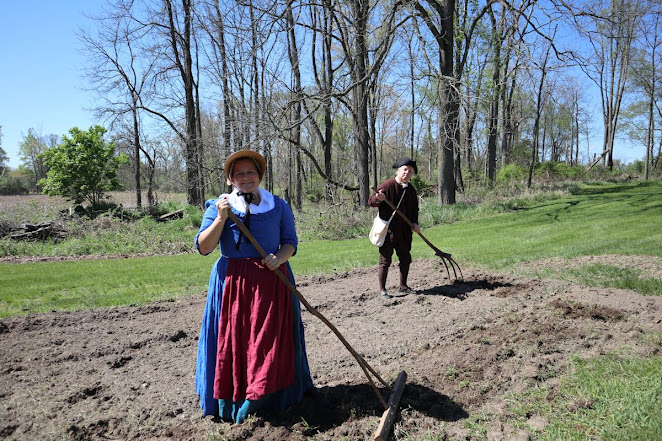 |
| After the good folks at Waterloo plowed the ground, Larissa and I prepared it for planting. |
 |
| And that's exactly what we did - we sowed flax, of the heirloom variety. |
Jackie and Charlotte also came out and helped with the planting.
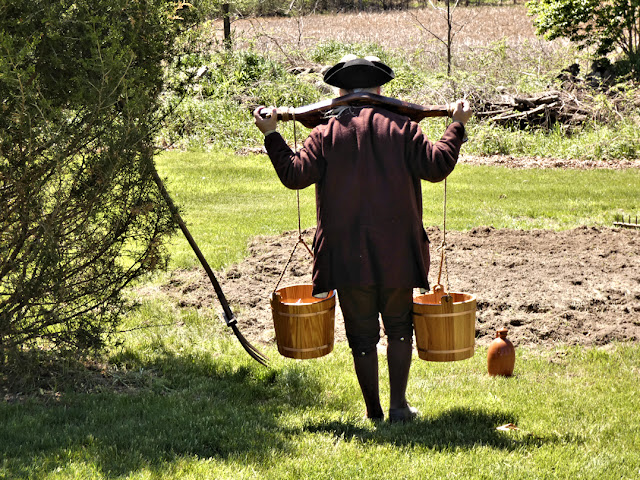 |
| The experience of carrying water to the flax patch. Yes, it was heavy. |
 |
| And utilizing the colonial-era watering jug. |
 |
| And finally, our afternoon dinnertime meal. |
 |
Say what you want about reenactors and living historians...
- I am blessed to be with the best. |
Still in the month of May, this next photo is not exactly a reenactment but, rather, a moment to teach my grandchildren about chores and crafts and activities of long, long ago:
 |
My three grandchildren absolutely loved breaking flax. So much so that they
continue to ask when they can do it again.
History runs deep in our veins. |
We're not quite done with May just yet.
Since Greenfield Village's Civil War event was put on hold for yet another year, the Port Sanilac Historical Society held a historical time-line. Of course, we had a fine representation for the Revolutionary War period.
 |
| Paul Revere, Benjamin Franklin, and Sybil Ludington at your service! |
 |
| Paul and Rachel Revere. |
 |
| Colonial ladies... |
 |
| ...and gentlemen. |
The timeline went from the American Revolutionary War through the Korean War.
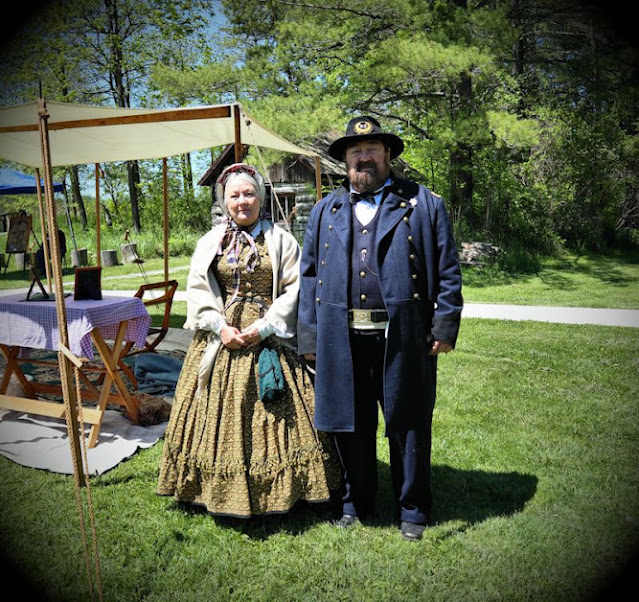 |
| And, of course, included the Civil War era. |
We are now in
June, and, unlike 2020, the reenacting season continues onward and upward.
 |
| Back at Port Sanilac for the Lac Ste. Clair Voyageur encampment. |
 |
| Dr. Bloodsworth bled Jackie, for she was not feeling well. |
 |
| They have a cabin there as well - - and I'm heading towards it! |
Another Voyageur encampment, this time in Chesterfield Township, followed:
 |
Spending time at another timeline, though this one was in Chesterfield Township.
Yes, if you give me the choice, I will choose 18th century every time! |
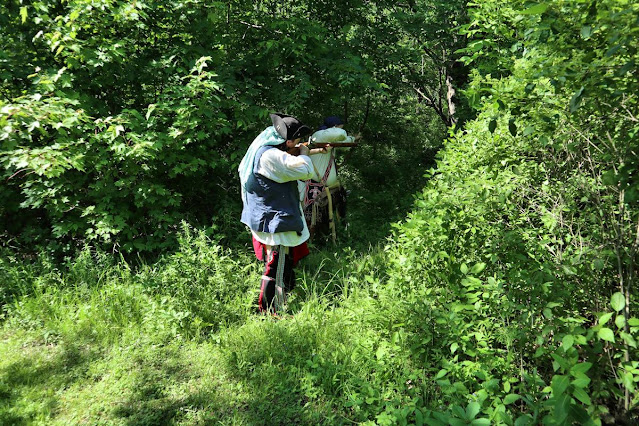 |
| Ah...there's Richard and Joey going after a deer. |
And not long after Chesterfield, we were in downtown Detroit:
 |
Fort Wayne in Detroit holds a Revolutionary War/Colonial event every year.
Many people do not know that Detroit played a role in not only the Revolutionary War, but even more so in the War of 1812!
I do not do the War of 1812, however, though it is of interest to me historically. |
 |
| Inside the first floor of the barracks gives a wonderful impression of the era we are representing. |
 |
| Mark, representing Native Americans, and Ken, a man who has been in this hobby longer than I've been alive! |
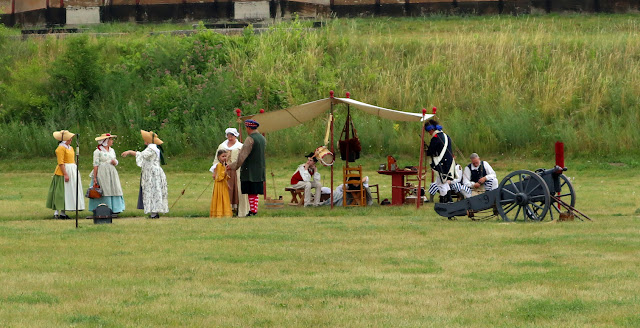 |
| Such a scene of the past - it could almost be a painting. |
The month of July was another busy month.
Yes, things are opening up and I am grabbing the opportunity with both hands!
 |
Independence Day - The 4th of July - my second favorite holiday, only following Christmas. And here I am, spending a good part of this Holiday where I should be - amongst structures that were around and standing and lived in at the time of the writing and signing of the Declaration of Independence!
They now stand in Greenfield Village, of course! |
 |
| And speaking of the Declaration, here am I, reading that most important of documents (for without it we could not have the Constitution!) to the good Citizens of the American Colonies while in the doorway of another 18th century home. |
 |
And I simply cannot visit Greenfield Village without stopping at my favorite home, The Daggett House. As you see here in this photo, our living history group is joined by members of the Daggett presenting staff.
|
But that wasn't all we did - - the next day, July 5, found us at Historic Mill Race Village. Some of the same people joined us there, but a few others came along as well.
I love celebrating the Independence Day holiday in this manner!
 |
| The day was hot, but sitting 'neath the shade of the trees sure did help quite a bit. |
 |
| Katherine and Noelle take a stroll near the blacksmith shop. |
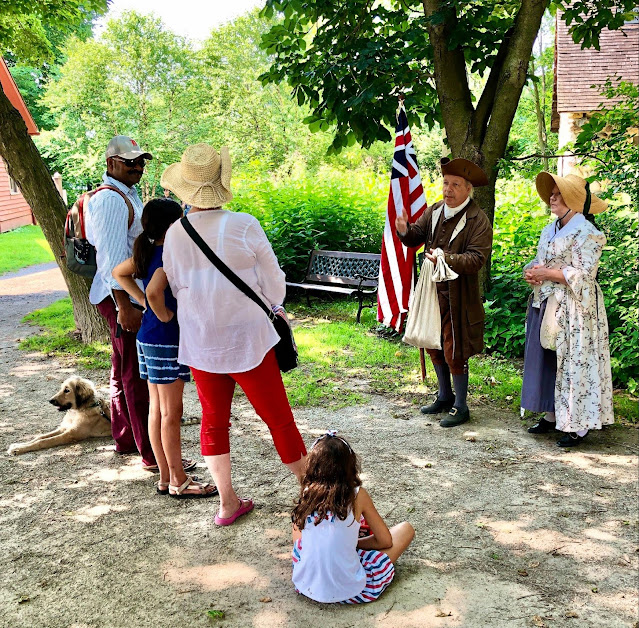 |
And, yes, we even presented to a few passersby.
No, nothing we did for this holiday was "official," but I know we made it
extra special for some.
And memorable.
|
 |
| Our Day After Independence Day group at Mill Race Village. |
Only a week after the 4th of July, on July 11, my son Robbie and I took part in a fashion show to help the Governor Warner Mansion in Farmington, Michigan.
 |
| A portion of the fashion show line up, showing the later 18th century and early 19th century. |
 |
Picture taken by Shiva of Seven Tones Photography of my
son and I with another "fashion model." |
And here we are toward the end of July, the weather being beautiful - perfect for reenacting in the Bavarian city of Frankenmuth, Michigan.
 |
| Jennifer and her son play games on the green. |
 |
Some folks were selling their wares.
I purchased another wooden bucket. |
 |
| This was the first reenactment I attended this year to have an actual battle. |
The day after Frankenmuth found me jumping from the 1770s to the 1860s in Hastings, Michigan over at historic Charlton Park.
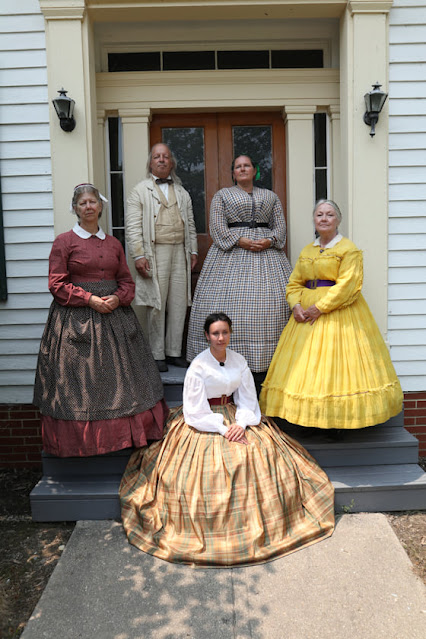 |
Meet the Logan Family.
We have been portraying this fictitious Maryland family
for nearly a decade, and we do quite well at it. |
 |
As the Logans, we are given a house - the Sixberry House (built in the 1850s) - and enjoy
spending a day representing how a family may have lived during the Civil War.
In this photo you see, on the left, Jackie, representing my sister, me, to my immediate right Larissa portraying my wife, and on the far right is Jillian, who becomes our daughter. |
 |
| Charlton Park is a perfect example of small-town America, circa mid-19th century. |
 |
| Of course, there is a battle, sometimes taking place right in our town! |
Meanwhile, back at the frontier cabin, there is some weeding that needs to be done!
 |
Oh! This was a warm day indeed!
But we were ready for it! |
 |
Now, if planted correctly, flax would not need any weeding,
for they're supposed to be planted pretty much all over each other,
not allowing for any weeds to peep through |
 |
However, this was my first year ever planting flax and I was not aware.
Or, if I was told, I had forgotten. So a-weeding we did go.
Larissa could not make it for this, though Jackie & Charlotte came out with me. Oh, our backs hurt! |
 |
We were hot and sweaty and dirty, just like colonial farmers should be in July.
It felt good!
Experience!! |
As summertime continues, we move to the month of August.
We did an outdoor school presentation. For the first time, Taylor took part with us.
 |
| Taylor, who is also a historic presenter at Greenfield Village, speaks with the middle school kids about the times of the Civil War. |
 |
The four of us really gave a well-rounded over-view of the different aspects of
life in the north and as a soldier during the 1860s. |
Heading into the thumb of Michigan, we're back at Port Sanilac!
 |
| My lovely wife and I. |
 |
Sandy Root gave a wonderful presentation about 19th century mourning traditions.
As you can see, she had a packed house. |
 |
It was very unfortunate that only a handful of military showed up.
This has been happening quite a lot over the last five or six years - even before covid. |
Colonial Kensington is one of my favorite events in the RevWar world.
 |
| Colonial Kensington is one of the larger Revolutionary War events, though numbers were a bit down this year. No fear - I believe in 2022 it will come back strong. |
 |
| Yes, this is a silhouette of me at Kent Lake. |
 |
Proud Patriots!
We side with George Washington's Continental Army! |
Knowing that flax matures in 90-100 days, and we planted it on May 8, I was aware that it would be ready for harvesting way before the fall months - sometime in mid-August - and I had to make a harvest plan for when it was ready to be pulled, for there is only a short window of time to harvest the plant.
So when I received the word it was ready, my wife, Patty (who has not been a part of the 18th century cabin crew), mentioned she wouldn't mind coming out with me, especially if I could not get others to join me at such a last minute decision. I told her that in keeping in the spirit of the past and of our farming ancestors, it was to be a period-dress trip, for we've planted and cared for these heirloom plants all along while in the 18th century and I wanted the entire process to be done in the same manner.
She agreed.
So off to the cabin we did go as soon as we got the call,
the flax was ready, we pulled it steady,
down to the roots and all.
Okay...so I'm not much of a poet (and don't I know it!), but it is exactly what we did!
 |
We arrived mid-afternoon on a very hot and muggy day - August 20, to be exact - wearing the clothing of our ancestors, ready to become Samuel & Anna Daggett or my 18th century 5th great grandparents Jonathan and Suzanna Heacock (lol). The heat was truly on. |
 |
| Not afraid to get my clothes or hands dirty. |
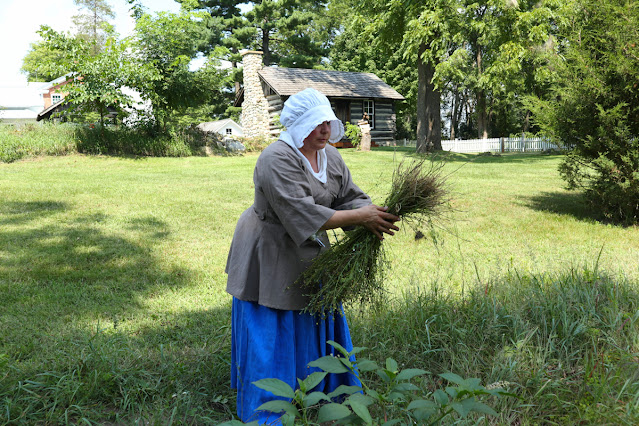 |
| And neither is my wife. |
 |
This was definitely a period moment. We looked and felt the part...there was not another soul in sight - past or present. How real is that? |
Yes, even at home I kept the processing period:
 |
I posted on Facebook some of the photos of my wife and I taken on flax harvest day, and upon seeing them my friend Steve F. wrote: "Keeping it period throughout is so commendable though. Totally your style, the dedication of a living historian, not just a reenactor." And another friend, John R., wrote: "I must say, sir, you definitely 'walk the walk.' "~ So when does living history cease to be pretending...? |
The Lac Ste. Claire Voyageurs event, which occurs near the end of August, is another favorite.
 |
| Three historic flags of the 1770s a-waving in the wind... |
 |
I brought my flax processing tools along and drew decent crowds.
I love being able to teach the old ways to folks interested in the past. |
 |
| And when I wasn't around the camp site, Charlotte and Jackie took over. |
 |
~Jackie, Charlotte, and Larissa~ I am going to take a moment here to speak about these three ladies: they have been my constant living history partners/companions for over a year now. They have taken part in our living history excursions at not only reenactments, but at the frontier cabin. The knowledge shared by each is astounding. |
September
Nothing was going on in the reenacting world in my neck of the woods that I was able to attend.
October
Due to a very serious illness I had, taking part in some of my most favorite of reenactments did not happen this month. If you know me at all, you know this Autumn time of year is my absolute favorite. It's when all the leaves are changing, and the feel of the past immerses one, whether they want to be or not.
But for this year, for me, it was not meant to be. The month of October, unfortunately, found me with a pretty bad case of covid.
Yes...it was bad.
No, it was not a very bad cold.
No, it was not a very bad flu.
It was far worse than I ever could have imagined it to be, and unless you've had what I (and so many others) have had, you cannot empathize or even try to understand...it also takes its sweet old time going away.
November
The term "Living Historian" is often misapplied to anyone who attempts to convey information about the past while dressed in period clothing. However, Living History, by definition, is an activity that incorporates not only period clothing, but historical tools and activities into a living, breathing history-book-come-to-life that seeks to give participants and observers a sense of stepping back in time, usually through action. Although living history does not necessarily seek to reenact a specific event in history, such as a particular battle or a famous speech, it is similar to, and sometimes incorporates, historical reenactment.
That being said, here we are, back at the frontier for another fall day...
 |
Charlotte, Jackie, Larissa, and myself. We make a great living history team. |
...only this time we are making beeswax candles.
 |
Here you see "our" cabin - we are so very thankful to be able to utilize it in such a manner that we make it our 18th century home. I am sitting here a-waiting for the wax to melt - it's a long process to make homemade lighting! At least it was a beautiful fall day. |
 |
| Making candles over an open fire with friends while wearing period clothing at the cabin on a perfect crisp fall day is a great tradition. Like the way we pulled and prepared the flax for processing, these candles will be a bit extra special because of that. |
 |
Many people believe that cooking on the hearth is like cooking over an open fire. Well, all three of these ladies will tell you that is a wrong assumption. Under the watchful eye of Larissa over the past year, Jackie and Charlotte, during our cabin excursions, have certainly received a wonderful lesson in historic cooking. |
On our way back to the 21st century we spoke on other period crafts that we can do for future-past endeavors, such as soap making, dyeing wool with natural dyes, possibly making beer (if we will be allowed to), as well as continue to do some of the flax planting, growing, harvesting, and processing, spinning, cooking on the hearth, threshing, candle making, perhaps with tallow as well as beeswax, and other daily life activities of the 18th century.
And wouldn't it be fun to plow the flax field by way of horses?
Yeah...just a few of the many ideas we have come up with.
And this takes us to late November and Thanksgiving Weekend.
Yes, I said "Thanksgiving Weekend."
It was on the Saturday that me and a few friends (grammatically incorrect, I know), visited Greenfield Village rather than spend our days in a store.
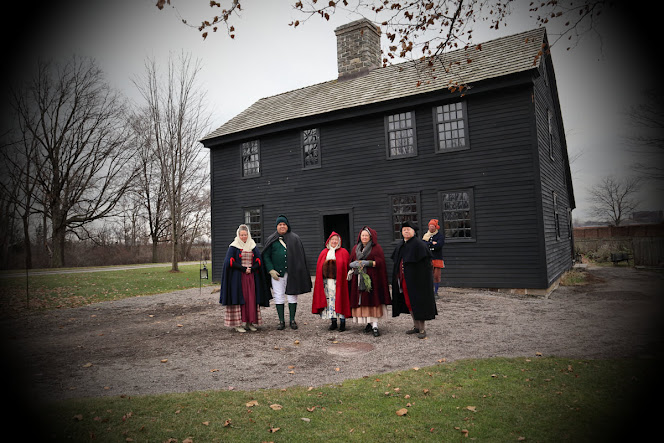 |
There were five of us who dressed in our colonial-era clothing on this day. Being that the temperature was on the cool side - right around freezing - there weren't too many other visitors there initially. |
 |
I do like how the structures from the 18th century (and earlier) are mostly in the same area. If you look in the background of this picture, you can easily see the Cotswold Cottage in the center and the Daggett House on the far right. Directly across the street is the Plympton House. Only the 1789 McGuffey Cabin has been placed further down the road. |
By late morning we were in the midst of a winter wonderland, the snow flying.
 |
I grabbed the opportunity to get some wintery shots on the other
side of the Village - backtracking back to Daggett! There is a sort
of short cut along the circular pond where the old steamboat
used to be, and that's the route I took. In this picture by
Catherine Marie Wrublewski-Kendzior I was really hoofing it
- huffin' and puffin' to get to the Daggett House
while the snow covered the ground. |
 |
| It's not often one gets the chance to be at the Village while it snows, so this was simply wonderful! |
December - Christmas at the Fort:
Not reenacting...but actually celebrating!
 |
My 1860s family~ The group of finest living historians I've ever had the pleasure to work with (yeah, one or two are missing, but we'll get 'em here next year). From left: Jackie (portraying my sister), me, Larissa (portraying my wife), Charlotte (portraying Larissa's sister), and standing in the back is our servant girl Carrie (portraying Agnes) with her daughter...who, dare I say, kind of almost seemed like mine and Larissa's granddaughter. |
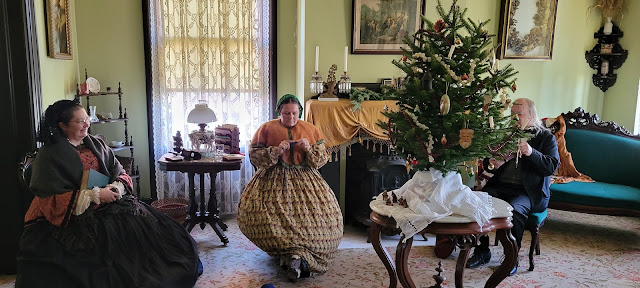 |
We've been doing Christmas at the Fort for over a decade now.
We kinda know how to bring Christmas Past to life... |
 |
Since 2013 we have been able to eat our "Christmas Eve" meal inside the dining room of this historic house. Out of everything we do throughout the day, this may possibly be our biggest highlight. Or, after this year, tied with the top, as you shall see. |
 |
The moment captured here and in the following two pictures was indescribable. This just may have been the most "Victorian" we have ever become during any of our Christmas excursions. I cannot even begin to express the feeling we each had. It was, simply put, one of those unforgettable moments. |
 |
And to make it even better, we had the tour group - the last group of visitors for the night - sing "Silent Night" while watching the tree all aglow. A true immersion you are there feeling overwhelmed us. We have been doing this together - Larissa & I - since 2009, and over the years we've had other wonderful living historians come and go in our "family." I am very proud of what we have been able to accomplish with each person who has joined us as far as having a sort of time-travel experience. |
And in late December we had our final trip to Greenfield Village to visit for their Holiday Nights event. Yep, a few of us enjoyed ourselves as we wore our period colonial clothing.
And - we were truly blessed! - we had another snowfall while there----the only time during Holiday Nights it snowed...seemingly especially for us!!.
 |
| Kinda hard to tell but in this photo you see me, up front, followed by my friends Jennifer and Amy. We so very much enjoyed our evening winter walk with the lanterns guiding our way. |
 |
The entire atmosphere of Greenfield Village changes when the snow falls.
This photo was taken by Ed Davis. |
 |
Historic Daggett presenter, Gigi, greeted me as I moved toward the house.
How could she tell it was me?
lol |
 |
If you look toward the right of this picture, you can barely make me out there,
staring at the glowing fire in the hearth inside the Daggett House. |
 |
After a short stay to warm up, it was time to leave to see other houses.
Photo taken by Ed Davis. |
 |
| At the Giddings House I set up a little photo shoot between Jennifer Long and I - she as the maid who "tripped to the door and slipped back the lock," and me as a guest to their New Year's Eve gathering. |
And it was at Greenfield Village that my 2021 reenacting season ended.
I've said it before and I'll say it again: I sometimes feel I am in my period clothing more than I am in contemporary styles. And the funny thing is...my colonial clothes especially feel very comfortable - more comfortable in many ways than my modern clothing.
I am being serious here.
Now, as for my Civil War clothes...that's a little different. They are more akin to wearing a modern suit and tie, which is not my cup of tea. But the squared-off style is much better when I am with others dressed in the same-era fashion, for then we, together, create a "look."
Plus, top hats are pretty cool.
Some folks reenact to teach. Some to learn. Others to experience.
Put me in all three categories. Each time I put on the clothing of the past, I consider myself a reenactor to some extent, for that's where the experiencing the past part takes place.
There are a few, however, who vehemently disagree.
I don't care - it's my experience, not theirs, right?
Now there are varying levels of what we generally call reenactors. What you are about to read comes from my own perspective - what I actually witness and hear:
MAINSTREAMERS - use general-line clothing and accessories from sutler-row and usually exhibit a "this is only a hobby" mentality. Mainstreamers run the gamut from generally accurate in their outward presentations to not-so-good. A trained eye can tell the difference.
However, MAINSTREAMERS - good or bad - are not always accepted by those who put themselves in the PROGRESSIVE or HARDCORE stage. In fact, there seems to be a constant snarky battle going on between them.
PROGRESSIVES – are reenactors that reach the stage when they begin making an all out effort (within the limits of their finances) to get things as right as possible. They'll usually have an increased interest in doing Living History, and a 1st Person mentality prevails. Oftentimes, PROGRESSIVES will bounce back and forth, from PROGRESSIVE to MAINSTREAM and back to PROGRESSIVE again. They may also dip their feet in the HARDCORE camp every-so-often. Generally, they are more accepting of MAINSTREAMERS than those who do HARDCORE reenacting.
HARDCORE - This is where complete immersion is the goal. Finances be d***ed, there are no excuses to be made at this level. Do it right or don't do it. At times some can let their Hardcore-ness over ride everything else, including the fun of the hobby.
Now, remember - this is not all HARDCORE reenactors. I know quite a few who, as mentioned, are pretty cool and enjoy the hobby in a more kind and accepting way.
Now, where do I fit in?
All three.
Throughout the year you may find me, at times, in each category. And I do not place one level over another because I believe there is room for all three in this hobby. And because I bounce around the three different types, there are some who snub their noses at me.
That's okay. I don't like snub-noses anyhow (lol).
So now you know a bit on the behind the scenes in the reenacting world.
You also know where I stand in this hobby.
And I hope you enjoyed my 2021 rendition of my year in the past.
Until next time, see you in time.































































































